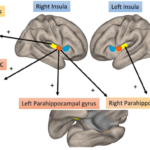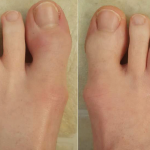The data indicate that the proportion of CPPD patients with PsA was double that of the controls and that more CPPD patients were diagnosed with psoriasis than controls. In about 62% of patients, the diagnosis of PsA preceded that of CPPD by at least a year.
These findings raise interesting questions about the interplay between inflammatory and degenerative disease, including the role of trauma in pathogenesis. These findings also have impact clinically in assessing the respective roles of PsA and CPPD in driving symptomatology, with ongoing crystal-induced arthropathy perhaps accounting for treatment resistance among some patients with PsA.
6. Fragility Fracture
Abstract 1451: Amin et al.6
PsA and RA are systemic inflammatory diseases with articular and extra-articular manifestations. Although both are marked by polyarthritis, PsA and RA nevertheless show notable differences, including the male-female ratio, and management options include the range of approved biologic therapies. Another difference concerns the use of glucocorticoids, with generally lower usage in PsA than RA.
Amin and Bukhari addressed another potential difference between these conditions and investigated issues of bone health and the occurrence of fragility fractures. This issue has been well analyzed with RA (including the role of glucocorticoid-induced osteoporosis [GIOP]), but the data on PsA are much more limited.
This study, which analyzed a group of 233 PsA patients who had been referred for dual-energy X-ray absorptiometry (DXA) scanning, made interesting observations including a lack of association with traditional risk factors with fractures and the occurrence of fracture at lower bone mineral density (BMD) than expected. In addition, the frequency of femoral fractures among PsA patients in this study was low; most of the fractures were vertebral.
Although the study is limited by patient numbers and risk of referral bias, nevertheless, the findings are important in sorting out the basis of bone loss in patients with inflammatory arthritis and the relative contributions of inflammation and GIOP; decreased mobility is another factor to consider. Future studies will be important in assessing the effects of the ever-increasing number of therapies for PsA on this common and often serious comorbidity.
7. Placebo Response Rates
Abstract 0772: Kerschbaumer et al.7
The treatment of PsA has shown rapid advances in the past two decades with the development of both biologic and targeted synthetic DMARDs. The regulatory approval of these agents has been based on the conduct of large randomized, controlled trials (RCT) using state-of-the-art outcome measures. Although RCTs are key to evidence-based medicine, they are nevertheless subject to variation with evolution of therapy and the expansion of clinical sites into less affluent countries to assure adequate recruitment.



